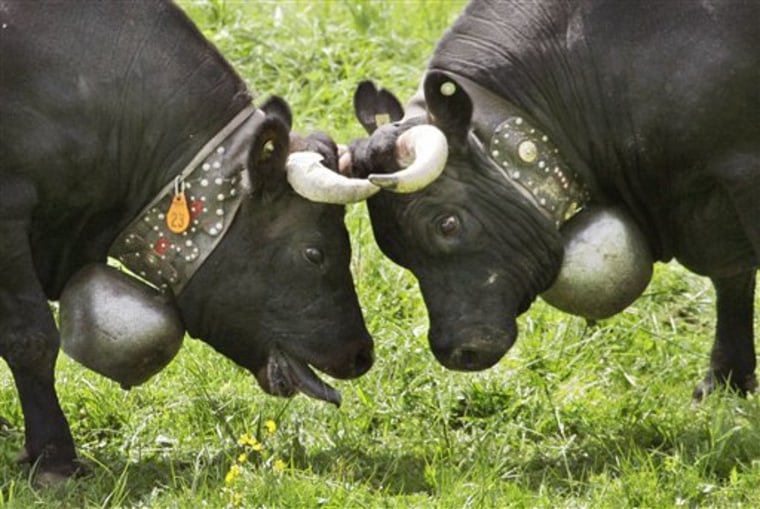Furie and Cigale eye each other warily, take a step forward and lock horns.
It's an ancient ritual, one that plays out each summer high in the Swiss Alps, as cows battle to be queen and villagers come to watch.
Judges record every fight as spectators sit on the surrounding mountainside, sipping local wines and cheering their family herd. But it is the cows who choose who to fight and who will reign supreme at the end of the season.
"They've been doing this ever since my grandparents were young, and even before that," says Marthe Vianin, once the proud owner of several fighting cows. "It's hundreds of years old."
Vianin, in her sixties, has come to watch her son's two cows — Tzardon and Bamby — take on champions from other herds.
Scars from past battles
Down in the corral, Bergamote faces off a challenge from Berkane with a fierce stare and a tussle of horns. No harm done. Still, there are clearly some seasoned fighters in this contest, judging from the scars they bear from past battles.
Locals insist the bovine power-struggle is both humane and irrepressible.
"It's very rare for them to hurt themselves," says Vianin.
The fighting season starts in early June, when cows are taken up to pastures 9,000-feet (2,700-meters) high and encounter rival herds. What follows are a hundred days of grazing on lush Alpine meadows — and lots of fighting.
Black, with short legs and built more like bulls than cows, the Herens breed found in the southern state of Valais is naturally competitive and will always establish their own hierarchy. Natural leaders distinguish themselves in battle, where strength and determination are key.
In the fall, the herds' return to the valley is marked by a celebration. Owners decorate their cows with flowers and giant bells and they parade through the village, led, of course, by the queen.
"It's a beautiful thing to see," says Trisha Cochrane from London, who owns a vacation home in the village of Grimentz.
There is no prize money for the winner, but owners can fetch a handsome price — up to $30,000 (euro21,000) — if they choose to sell a queen.
Most important, says local Albert Salamin, is the respect.
'More respected than the mayor'
The winner's owner is "king of the village for the year. He's more respected than the mayor," Salamin says to laughs from bystanders.
The Salamin brothers have several cows in competition, but Albert admits only his brother Armand's prize heifer Bolero stands a real chance this year.
Cow fighting is still taken seriously, but it's largely a hobby and a cherished tradition for most villagers, who have long since stopped living off the land.
Four-wheel drive cars and all-year tourism have changed life in these remote Alpine valleys, bringing prosperity and making cattle-rearing less appealing to a younger generation.
"Even 40 years ago, most families got much of what they needed from three or four cows," says Salamin. "Milk, cheese, meat, the cows provided it all."
